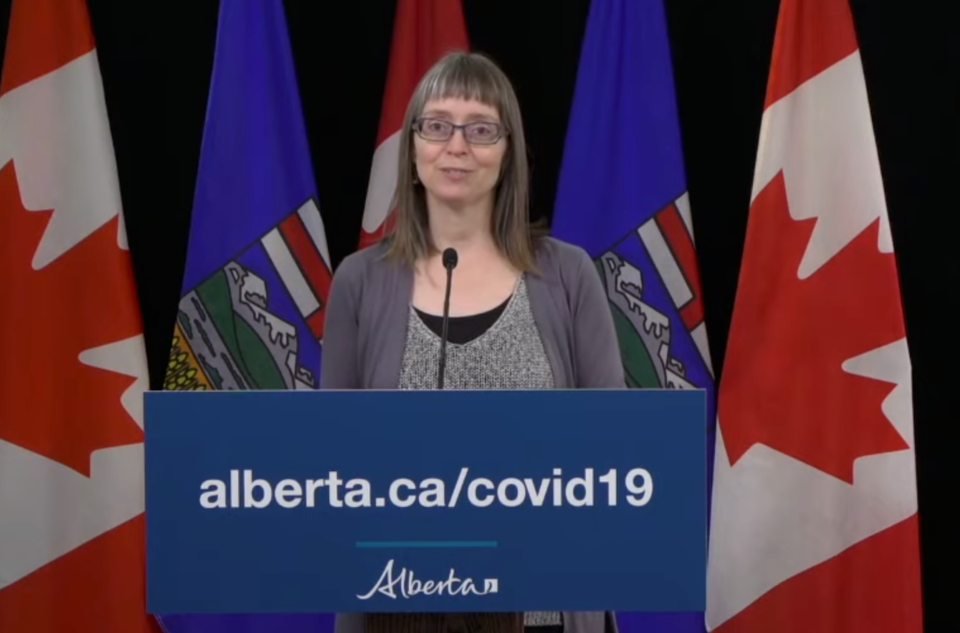ALBERTA – An outbreak of COVID-19 in nine continuing care facilities in the province has prompted the introduction of additional measures to help slow the spread of the virus in Alberta.
Alberta’s Chief Medical Officer of Health Dr. Deena Hinshaw reported 96 new cases of the virus Thursday (April 2) bringing the total number of diagnosed cases in the province to 968. Of those who have tested positive for COVID-19, 108 are suspected to be a result of community transmission.
“The safety in these [continuing care] facilities is a serious issue and one that is being faced across Canada, ” Hinshaw said.
“We are doing everything possible to protect them from COVID-19.”
A total of 13 people have died and 174 people have fully recovered from the virus.
There have been ten COVID-19 cases reported in the Canmore region and one case in the Banff region.
Under the new orders introduced by Hinshaw, staff and operators will be required to notify Public Health as soon as a case is suspected or confirmed, and if two or more people display COVID-19-like symptoms.
The additional standards for long-term care facilities that have been introduced in the event of a suspected or confirmed COVID-19 outbreak are enforceable by law, Hinshaw said.
Staff working at multiple facilities will be required to inform supervisors immediately if an outbreak is suspected at a workplace, Hinshaw added.
“We need to balance the need to make sure facilities stay staffed, also while making sure we limit exposure,” Hinshaw said.
Of the diagnosed cases of COVID-19 in the province, 74 are at continuing care facilities, 65 of which are at the McKenzie Town Continuing Care Centre.
That particular outbreak is concerning, Hinshaw said, and it serves as a reminder of the need for early notification of COVID-19 cases to ensure swift action can be taken.
Hinshaw said these actions will help ensure those living and working in a congregate setting are kept as physically safe as possible, while mitigating the spread of the virus within and between facilities.
Outbreaks are defined by three levels – a suspected outbreak with at least one person who has COVID symptoms, a probable outbreak where two or more people have COVID symptoms and a confirmed outbreak where one or more person has been diagnosed with COVID.
“These expectations are designed to limit the risk of spread while ensuring residents can continue to receive the care they need,” Hinshaw said.
“We are really carefully considering what other measures need to be put in place.”
These standards are the first step, Hinshaw said, adding the province is considering limiting workers to one facility like has been done B.C., but expressed concerns this could create a staffing shortage.
“It’s that balance of trying to move as quickly as we can while being thoughtful about the outcomes,” Hinshaw said.
It is unclear how long public health measures will be in place in the province, but she indicated it could be for many months.
Hinshaw said these measures have been introduced to slow the spread of the virus to prevent overwhelming hospitals and intensive care units preventing the delivery of adequate care to patients. She said the additional time gained by flattening the curve of the virus also allows for further research into effective treatments and the development of a potential vaccine for COVID-19.
“People end up dying not just from COVID, but from other diseases that may need hospital care,” Hinshaw said.
“People do need to be prepared for the fact that we will continue to be isolating those that have COVID, isolating those that have close contact with those individuals, that measures will be in place for many months.”
The province will be releasing modelling data on the projected peak and infection rate of the virus next week.
The release of these numbers will serve to help the public better understand how COVID-19 is spreading in the province and the importance of the measures that have been taken, Hinshaw said. She added that these numbers will be an estimate of what the pandemic could look like in the coming weeks and months.
“What we are seeing now isn’t the peak,” Hinshaw said. “It helps people think about the magnitude of the situation.”
Follow RMOToday.com's COVID-19 special section for the latest local and national news on the coronavirus pandemic, as well as resources, FAQs and more.




